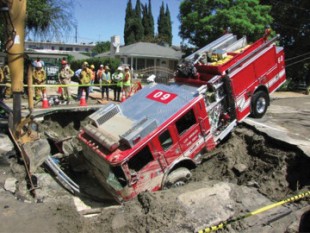A broken water pipe can mean flooded streets, damaged property, disrupted traffic, and income loss for local businesses. In the summer of 2009, the water system of Los Angeles experienced an unprecedented 75 of these water main blowouts. Notably, two transmission mains burst just days apart.
To Bardet and Little, the pattern of failures seemed similar to a phenomenon in epidemiology called “harvesting.” Through the wear and tear of daily life, people will naturally age and become frail. An added stress, say, a heat wave, will largely affect and kill the frailest members of the population.
Applying the concept of harvesting to Los Angeles’s pipes, the authors found that under pressure from shuttling water during the summer months, the number of pipe breaks surged, appearing in the data in a cluster. Then, just as deaths in a human population slow after a heat wave ends, the number of breaks slowed after the frailest pipes had already cracked, and the rest could handle the stress.
More work is needed to see if the harvesting model will accurately apply to data from other urban water systems. The authors suggest that pipe breaks could be mitigated the same way that epidemiologists have successfully advised hospitals to mitigate the effects of a heat wave: by strategically identifying which of the millions of pipes in an urban water system are likely to be frail from age (or other factors, like composition) and then caring for and replacing those vulnerable pipes on a priority basis. (Water Resources Research, doi:10.1002/2013WR015017, 2014)
—Shannon Palus, Writer
© 2014. American Geophysical Union. All rights reserved.
© 2014. American Geophysical Union. All rights reserved.

